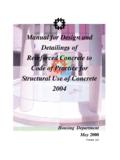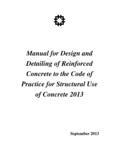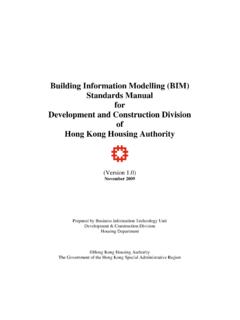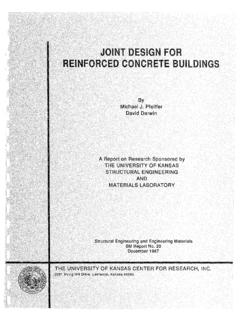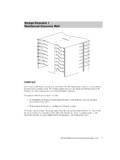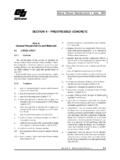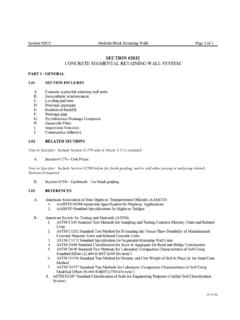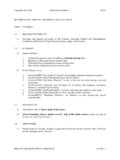Transcription of Manual for Design and Detailing of Reinforced …
1 Manual for Design and Detailing of Reinforced concrete to the Code of Practice for Structural Use of concrete 2013 September 2013 September 2013 Manual for Design and Detailing of Reinforced concrete to the Code of Practice for Structural Use of concrete 2013 Contents Introduction Some highlighted aspects in Basis of Design Beams Slabs Columns Beam-Column Joints Walls Corbels Cantilevers Transfer Structures Footings Pile Caps General Detailing Design against Robustness Shrinkage and Creep Appendices 1 September 2013 Manual for Design and Detailing of Reinforced concrete to the Code of Practice for Structural Use of concrete 2013 Introduction Promulgation of the Revised Code The revised concrete code titled Code of Practice for Structural Use of concrete 2013 was formally promulgated by the Buildings Department of Hong Kong in end February 2013 which supersedes the former concrete code 2004.
2 The revised Code, referred to as the Code hereafter in this Manual will become mandatory by 28 February 2014, after expiry of the grace period in which both the 2004 and 2013 versions can be used. Overview of the Code The Code retains most of the features of the 2004 version though there are refinements here and there, some of which are subsequent to comments obtained from the practitioners ever since the implementation of the 2004 version. The major revisions in relation to Design and Detailing of Reinforced concrete structures are outlined as follows : (i) Introduction of the fire limit state; (ii) A set of Young s moduli of concrete which are average values is listed in the Code, as in addition to the characteristic values originally listed in the 2004 version.
3 The average values can be used in determination of overall building deflection. In addition, the initial tangent in the concrete stress strain curve for Design (in Figure of the Code) has been given a separate symbol Ed which is different from the Young s modulus of concrete with the symbol Ec as the two have different formulae for determination; (iii) The high yield bar (which is termed ribbed steel reinforcing bar in the Code as in CS2:2012) is upgraded to Grade 500 to CS2:2012, the yield strength is upgraded from 460 yfMPa to 500 MPa; (iv) The use of mechanical coupler Type 1 and Type 2.
4 (v) The determination of Design force on the beam column joint has been clarified, together with revision in Detailing requirements in some aspects; (vi) The discrepancies in Design provisions of cantilevers between the 2004 version and the PNAP 173 have generally been resolved in the Code; (vii) Additional reinforcement requirements in bored piles and barrettes; (viii) Refinement of ductility Detailing in beams and columns; (ix) Additional ductility Detailing in walls. In the aspects of Design and Detailing , the drafting of the Code is based on the following national and international codes, though with modifications or simplifications as appropriate: (i) The British Standard BS8110 Parts 1 and 2 generally for most of its contents; (ii) The Eurocode EC2 on Detailing as mostly contained in Chapter 8; (iii) The New Zealand Standard NZS 3101 in the Design of beam column joint.
5 2 September 2013 Manual for Design and Detailing of Reinforced concrete to the Code of Practice for Structural Use of concrete 2013 (iv) The New Zealand Standard NZS 3101 in most of the provisions of ductility Detailing for beams and columns; (v) The ACI Code ACI318-2011 for modifications of some of the Detailing ; (vi) The China Code GB50011-2010 in some respects of Detailing including that of wall. (vii) The Eurocode BSEN 1536 for the Detailing of bored pile and diaphragm wall.
6 However, the properties of concrete including the Young s modulus and the stress strain relationships are based on local studies by Professor Albert Kwan of the University of Hong Kong. Outline of this Manual This Practical Design and Detailing Manual intends to outline practice of detailed Design and Detailing of Reinforced concrete work to the Code. Detailing of individual types of members are included in the respective sections for the types, though the Section 13 in the Manual includes certain aspects in Detailing which are common to all types of members.
7 The underlying principles in some important aspects in Design and Detailing have been selectively discussed. Design examples, charts are included, with derivations of approaches and formulae as necessary. As computer methods have been extensively used nowadays in analysis and Design , the contents as related to the current popular analysis and Design approaches by computer methods are also discussed. The background theory of the plate bending structure involving twisting moments, shear stresses, and Design approach by the Wood Armer Equations which are extensively used by computer methods are also included an Appendix (Appendix D) in this Manual for Design of slabs, pile caps and footings.
8 To make distinctions between the equations quoted from the Code and the equations derived in this Manual , the former will be prefixed by (Ceqn) and the latter by (Eqn). Unless otherwise stated, the general provisions and dimensioning of steel bars are based on ribbed steel reinforcing bars with 500 yfN/mm2. Design charts for beams, columns and walls are based on the more rigorous stress strain relationship of concrete comprising a rectangular and a parabolic portion as indicated in Figure of the Code. 3 September 2013 Manual for Design and Detailing of Reinforced concrete to the Code of Practice for Structural Use of concrete 2013 Some Highlighted Aspects in Basis of Design Ultimate and Serviceability Limit states The ultimate and serviceability limit states used in the Code carry the normal meaning as in other codes such as BS8110.
9 However, the Code has incorporated an extra serviceability requirement in checking human comfort by limiting acceleration due to wind load on high-rise buildings (in Cl. ). No method of analysis has been recommended in the Code though such accelerations can be estimated by the wind tunnel laboratory if wind tunnel tests are conducted. Nevertheless, worked examples are enclosed in Appendix A, based on empirical approach in accordance with the Australian/New Zealand code AS/NZS :2011. The Australian/New Zealand code is the code on which the current Hong Kong Wind Code has largely relied in deriving dynamic effects of wind loads.
10 Design Loads The Code has made reference generally to the Code of Practice for Dead and Imposed Loads for Buildings 2011 for determination of characteristic gravity loads for Design . However, the designer may need to check for the updated loads by fire engine for Design of new buildings, as required by FSD. The Code has placed emphasize on Design loads for robustness which are similar to the requirements in BS8110 Part 2. The requirements include Design of the structure against a notional horizontal load equal to of the characteristic dead weight at each floor level and vehicular impact loads (Cl.)
